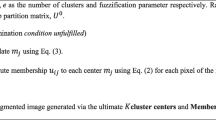Abstract
The aim of colour quantisation is to reduce the number of distinct colour in images while preserving a high colour fidelity as compared to the original images. The choice of a good colour palette is crucial as it directly determines the quality of the resulting image. Colour quantisation can also be seen as a clustering problem where the task is to identify those clusters that best represent the colours in an image. In this paper we investigate the performance of various fuzzy c-means clustering algorithms for colour quantisation of images. In particular, we use conventional fuzzy c-means as well as some more efficient variants thereof, namely fast fuzzy c-means with random sampling, fast generalised fuzzy c-means, and a recently introduced anisotropic mean shift based fuzzy c-means algorithm. Experimental results show that fuzzy c-means performs significantly better than other, purpose built colour quantisation algorithms, and also confirm that the fast fuzzy clustering algorithms provide similar quantisation results to the full conventional fuzzy c-means approach.
Similar content being viewed by others
References
Ahmed, M., Yamany, S., Mohamed, N., Farag, A., & Moriaty, T. (2002). A modified fuzzy c-means algorithm for bias field estimation and segmentation of MRI data. IEEE Trans. Medical Imaging, 21, 193–199.
Bezdek, J. (1980). A convergence theorem for the fuzzy isodata clustering algorithms. IEEE Trans. Pattern Analysis and Machine Intelligence, 2, 1–8.
Cai, W., Chen, S., & Zhang, D. (2007). Fast and robust fuzzy c-means clustering algorithms incorporating local information for image segmentation. Pattern Recognition, 40(3), 825–838.
Chen, S., & Zhang, D. (2004). Robust image segmentation using FCM with spatial constraints based on new kernel-induced distance measure. IEEE Trans. Systems, Man and Cybernetics – Part B: Cybernetics, 34, 1907–1916.
Cheng, T., Goldgof, D., & Hall, L. (1998). Fast fuzzy clustering. Fuzzy Sets and Systems, 93, 49–56.
Chuang, K., Tzeng, S., Chen, H., Wu, J., & Chen, T. (2006). Fuzzy c-means clustering with spatial information for image segmentation. Computerized Medical Imaging and Graphics, 30, 9–15.
Comaniciu, D., & Meer, P. (1999). Mean shift analysis and applications. In 7th int. conference on computer vision (pp. 1197–1203).
Comaniciu, D., & Meer, P. (2002). Mean shift: a robust approach toward feature space analysis. IEEE Trans. Pattern Analysis and Machine Intelligence, 24, 603–619.
Dekker, A. (1994). Kohonen neural networks for optimal colour quantization. Network: Computation in Neural Systems, 5, 351–367.
Eschrich, S., Ke, J., Hall, L., & Goldgof, D. (2003). Fast accurate fuzzy clustering through data reduction. IEEE Trans. Fuzzy Systems, 11, 262–270.
Gervautz, M., & Purgathofer, W. (1990). A simple method for color quantization: octree quantization. In: A. Glassner (Ed.), Graphics gems, (pp. 287–293).
Heckbert, P.S. (1982). Color image quantization for frame buffer display. In ACM computer graphics (ACM SIGGRAPH ’82 proceedings) 16(3), 297–307.
Hu, R., & Hathaway, L. (2002). On efficiency of optimization in fuzzy c-means. Neural, Parallel and Scientific Computation, 10, 141–156.
Kolen, J., & Hutcheson, T. (2002). Reducing the time complexity of the fuzzy c-means algorithm. IEEE Trans. Fuzzy Systems, 10(2), 263–267.
Leski, J. (2003). Toward a robust fuzzy clustering. Fuzzy Sets and Systems, 137, 215–233.
Nolle, L., & Schaefer, G. (2007). Color map design through optimization. Engineering Optimization, 39(3), 327–343.
Schaefer, G., Qiu, G., & Finlayson, G. (2000). Retrieval of palettised colour images. In Storage and retrieval for image and video databases VIII. Proceedings of SPIE (Vol. 3972, pp. 483–493).
Scheunders, P. (1997). A genetic c-means clustering algorithm applied to color image quantization. Pattern Recognition, 30(6), 859–866.
Szilagyi, L., Benyo, Z., Szilagyii, S., & Adam, H. (2003). MR brain image segmentation using an enhanced fuzzy c-means algorithm. In 25th IEEE int. conference on engineering in medicine and biology (Vol. 1, pp. 724–726).
Wang, J., Thiesson, B., Xu, Y., & Cohen, M. (2004). Image and video segmentation by anisotropic kernel mean shift. In 8th European conference on computer vision (pp. 238–2492).
Zhang, X., & Wandell, B. (1998). Color image fidelity metrics evaluated using image distortion maps. Signal Processing, 70(3), 201–214.
Zhou, H., Schaefer, G., & Shi, C. (2008). A mean shift based fuzzy c-means algorithm for image segmentation. In 30th IEEE int. conference on engineering in medicine and biology.
Author information
Authors and Affiliations
Corresponding author
Rights and permissions
About this article
Cite this article
Schaefer, G., Zhou, H. Fuzzy clustering for colour reduction in images. Telecommun Syst 40, 17–25 (2009). https://doi.org/10.1007/s11235-008-9143-8
Published:
Issue Date:
DOI: https://doi.org/10.1007/s11235-008-9143-8




